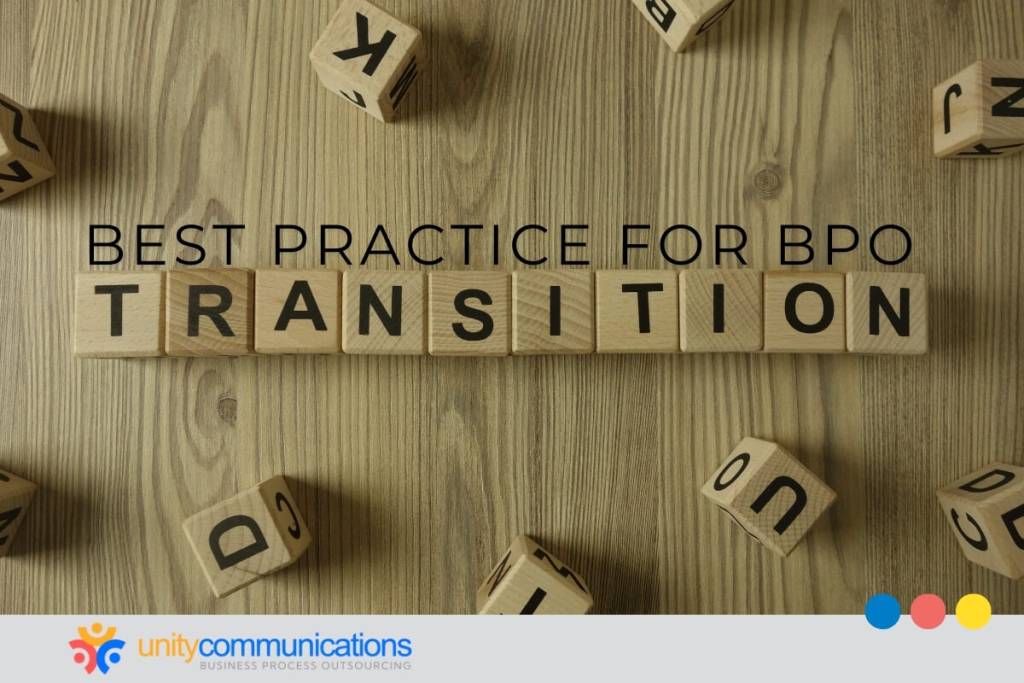Table of Contents
Outsourcing can be transformative for companies seeking to optimize operations, reduce costs, and focus on core competencies. However, without a well-structured approach, the shift to business process outsourcing (BPO) can bring challenges that undermine these benefits.
A smooth transition requires careful planning, clear communication, and strategic alignment between internal teams and external partners. Keep reading to learn best practices for BPO transition. This article helps you navigate the complexities of BPO integration for a seamless handover and long-term success.
Best practices for a smooth BPO transition

What is BPO transition? BPO transition is shifting specific business functions or processes from within an organization to an external service provider. The goal is to ensure the external provider can perform the outsourced tasks efficiently and meet the same or higher standards than the internal team.
The transition period is a critical phase in outsourcing, as it involves transferring knowledge, systems, responsibilities, and sometimes even personnel from the company to the BPO partner. A successful BPO transition requires meticulous planning, thorough documentation, clear communication, and continuous monitoring.
The transition period is crucial for establishing a solid foundation for the partnership, minimizing disruptions to business operations, and guaranteeing the arrangement delivers the desired benefits. Clients must follow best practices for BPO transition.
Here’s a step-by-step guide to managing the BPO transition process:
1. Assess changes to roles and organizational structure
Evaluating changes to roles and organizational structure is a best practice for BPO transition. When you contract BPO services, you inevitably affect the internal team’s roles and responsibilities. To avoid confusion and ensure a smooth transition, define how the changes can shape the organizational structure.
Identify which roles might be altered, merged, or eliminated and understand how these shifts align with the company’s strategic goals. Additionally, communicate these changes transparently to the affected employees. Provide them with the training or support to adapt to their new roles.
Addressing how the transition reshapes the organization proactively can minimize resistance, maintain morale, and improve the collaboration and alignment of internal team members and BPO workers.
2. Implement effective change management strategies
Another critical best practice for BPO transition is implementing effective change management strategies. Change management focuses on helping employees and stakeholders adapt to new working methods. Since a BPO transition often involves significant shifts in processes, roles, and responsibilities, managing the human side of the change is crucial.
The strategies include clear and consistent communication about the transition’s reasons, benefits, and impact. Involving employees early in the transition process can reduce resistance and build buy-in. In fact, 43% of employees believe this approach can invite more collaboration.
Proactively managing the cultural and emotional aspects of the transition fosters a positive environment that encourages cooperation, minimizes disruption during the transition, and accelerates the successful adoption of the new BPO arrangement.
3. Define clear transition objectives and goals
Defining clear transition objectives and goals is another best practice for a successful BPO transition. Without well-defined objectives, the transition process can lack direction, leading to misaligned expectations between your company and the BPO provider.
Setting specific, measurable goals helps all parties understand what the transition aims to achieve, whether it’s to achieve up to 70% cost savings, process efficiency, improved service quality, or access to specialized expertise. Communicate these objectives clearly to all stakeholders to keep everyone aligned.
Additionally, establish milestones and key performance indicators (KPIs) for progress monitoring of progress and early identification of issues. Defining clear objectives and goals creates a focused transition roadmap to ensure outsourcing delivers its intended benefits and aligns with your long-term strategy.
4. Develop a comprehensive transition plan
Another best practice for BPO transition is to develop a comprehensive transition plan. It is a detailed roadmap guiding the entire process, from in-house operations to outsourced services.
BPO long-term planning should cover timelines, responsibilities, resource allocation, risk management, and contingency strategies. It should also consider the gradual handover of tasks so that knowledge transfer is thorough and both parties can handle the transition’s complexities.
Effective communication and collaboration between your company and BPO partner are crucial to keeping the plan on track. Developing a comprehensive transition plan helps you anticipate challenges, manage risks, and ensure a smooth transition. It minimizes disruptions to business operations and lays the groundwork for a successful long-term partnership.
5. Set up a dedicated transition team
Setting up a dedicated transition team is a critical best practice for a smooth BPO transition. This specialized team, composed of key company and BPO provider stakeholders, oversees the transition process.
The team should include individuals with deep knowledge of the outsourced processes, expertise in project management, and the authority to make decisions. The team can meticulously manage the handover by focusing solely on the transition, from knowledge transfer to process alignment and risk mitigation.
The transition team also acts as the central point of communication. It coordinates efforts across departments, addresses issues, and aligns the company and the BPO provider with the transition objectives.
By following this best practice for BPO transition, you can better manage complexities, reduce the risk of disruptions, and facilitate a smoother, more efficient shift to outsourced operations.
6. Prepare the customers
Preparing customers is a crucial best practice for ensuring a smooth BPO transition, primarily when the outsourced processes directly affect their brand experience. Customers might notice service delivery, communication, or even product or service quality changes.
To maintain customer trust and satisfaction, openly communicate about the transition. Inform customers about the changes and their objectives. Transparency is key. Address any concerns and provide clear channels for feedback and support.
Additionally, include measures to maintain consistent service levels during the shift. Proactively engaging with customers and managing their expectations reduces the risk of dissatisfaction, preserves brand loyalty, and fosters a positive relationship during and after the transition to BPO services.
7. Ensure knowledge transfer and training
Thorough knowledge transfer is a best practice for a successful BPO transition. After all, effective knowledge transfer can increase productivity by 25%. As operations move from in-house teams to an external provider, ensure the BPO partner fully understands the company’s processes, standards, and expectations.
Create a structured knowledge transfer process that includes detailed documentation, hands-on training, and ongoing support. Carefully transfer explicit knowledge, such as process manuals, and tacit knowledge, such as insights gained from experience, to avoid operational gaps.
Additionally, train the BPO provider and remaining in-house staff to align them and improve their collaboration. Continuous communication and feedback during this phase help address misunderstandings or knowledge gaps early on.
8. Evaluate and adjust post-transition processes
Evaluating and adjusting post-transition processes is a crucial best practice for sustaining the success of a BPO transition. Once the transition is complete, continuously monitor the performance of the outsourced operations against the established objectives and KPIs.
Performance evaluation identifies areas where the BPO provider might need further alignment with the company’s expectations or where processes require fine-tuning. Regular assessments and open feedback channels between your company and the BPO provider allow for proactive adjustments that enhance efficiency, quality, and collaboration.
Post-transition evaluations also address unforeseen challenges or risks for quick resolutions. Treating the post-transition phase as an ongoing refinement process allows you to optimize the BPO partnership, maximize the benefits, and ensure that the transition delivers long-term value.
The bottom line

Following best practices relieves most of the pitfalls of BPO transition. A partnership that shares similar values and culture and implements robust processes sets a solid foundation for integration.
Use this transition period to thoroughly review and refine your processes while capitalizing on the BPO provider’s advanced technology and improved processes.
Ready to start outsourcing? Let’s connect!




